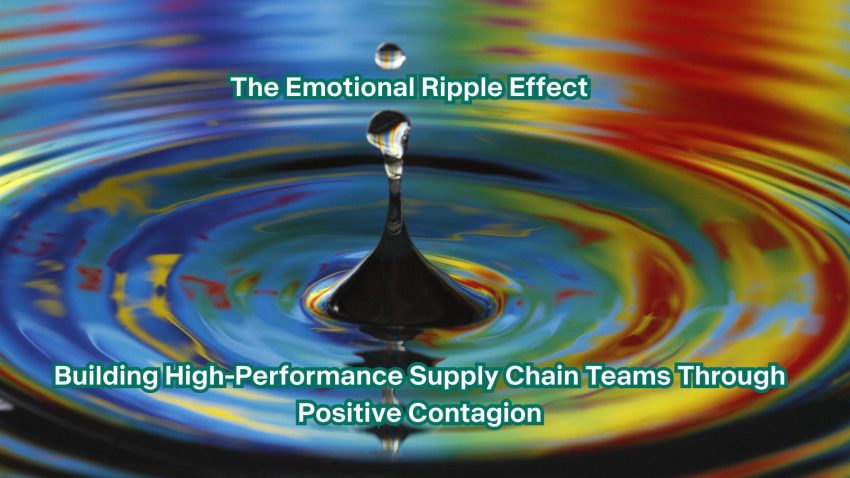In the fast-paced, high-stakes world of supply chain management, we often focus on metrics, processes and technology while overlooking one of the most powerful forces shaping our teams’ performance: emotional contagion. Behavioral scientist Peter Totterdell‘s groundbreaking research reveals a fascinating truth about workplace dynamics; when people work together, they literally infect each other with emotions to the point where they begin sharing the same emotional state, whether positive or negative.
This phenomenon has profound implications for supply chain professionals, where collaboration across multiple functions, time zones, and organizational boundaries is not just common but essential for success.
The Hidden Current Running Through Your Supply Chain
Think about the last time your planning team faced a critical supplier disruption. Did the stress and urgency spread through your organization like wildfire? Or consider when your logistics team successfully navigated a complex delivery challenge. Did that sense of accomplishment energize other departments? Totterdell’s research suggests that these emotional shifts aren’t coincidental; they’re the natural result of emotional contagion at work.

In supply chain operations, where teams are interconnected through shared goals, tight deadlines, and mutual dependencies, emotional states can cascade through the entire network with remarkable speed. A frustrated warehouse manager can inadvertently dampen the spirits of the transportation team. Conversely, an optimistic demand planning team can lift the entire organization’s confidence during uncertain market conditions.
The Competitive Advantage of Positive Team Dynamics
Supply chain excellence isn’t just about having the right processes and systems. It’s about having teams that can adapt, innovate, and persevere through challenges. When positive emotions spread through your supply chain organization, several powerful benefits emerge:
Enhanced Problem-Solving Capacity: Teams experiencing positive emotional states demonstrate greater creativity and flexibility when addressing complex supply chain challenges. Whether it’s finding alternative suppliers during disruptions or optimizing distribution networks, positive teams generate more innovative solutions.
Improved Cross-Functional Collaboration: Supply chains require seamless coordination between procurement, manufacturing, logistics, and customer service. When positive emotions create psychological safety and trust, these traditionally siloed functions work together more effectively.
Greater Resilience During Crisis: Supply chain disruptions are inevitable, but teams with strong positive emotional foundations bounce back faster. They view setbacks as temporary challenges rather than permanent failures, maintaining the persistence needed for long-term success.
Increased Customer Focus: Positive teams naturally extend their optimism and energy toward external relationships. This translates into better supplier partnerships, more proactive customer service, and stronger stakeholder relationships throughout the supply network.

Strategies for Cultivating Positive Emotional Contagion
Understanding that emotions spread naturally through teams gives supply chain leaders a powerful tool for organizational development. Here are practical strategies to foster positive emotional states:
Lead with Authentic Optimism: As Totterdell’s research shows, emotions spread regardless of hierarchy, but leadership influence is particularly strong. Supply chain leaders who model resilience, celebrate small wins, and maintain perspective during challenges set the emotional tone for their entire organization. This doesn’t mean toxic positivity. It means acknowledging difficulties while maintaining confidence in the team’s ability to overcome them.
Create Shared Victory Moments: Supply chains often focus on preventing problems rather than celebrating successes. Regularly highlighting team achievements, from successful product launches to cost reduction milestones, creates positive emotional experiences that spread throughout the organization. Make these celebrations inclusive, ensuring that behind the scenes contributors receive recognition alongside front-line heroes.
Foster Psychological Safety: Teams need to feel safe to share concerns, admit mistakes, and propose innovative solutions. When supply chain professionals know they won’t be punished for bringing forward problems or trying new approaches, positive emotions flourish. This safety net becomes especially crucial during high-pressure situations like supply disruptions or demand spikes.

Invest in Cross-Functional Relationships: Since emotions spread through personal connections, deliberately building relationships across supply chain functions amplifies positive contagion. Regular cross-functional meetings, joint problem-solving sessions, and informal team-building activities create the interpersonal bonds through which positive emotions travel.
Practice Emotional Awareness: Help team members recognize and name emotions including both their own and others’. When supply chain professionals can identify when stress or frustration is spreading through the team, they can take proactive steps to address root causes and shift the emotional trajectory.
The Long-Term Impact on Supply Chain Performance
Organizations that master positive emotional contagion don’t just create better workplace cultures. They also build sustainable competitive advantages. Teams that share positive emotional states demonstrate higher engagement, lower turnover, and greater innovation capacity. They attract top talent and develop stronger external partnerships.
Perhaps most importantly, they create supply chains that are genuinely resilient, not just because they have backup plans and redundant systems, but because they have people who remain committed, creative, and collaborative even when those plans are tested.
The science is clear: emotions are contagious, and this contagion significantly impacts team performance. Supply chain leaders who harness this phenomenon don’t just build better processes, they build better futures for their organizations and the customers they serve.
Do you agree that emotions are contagious? If yes, please share how it has influenced your team performance?

2 thoughts on “The Emotional Ripple Effect: Building High-Performance Supply Chain Teams Through Positive Contagion”